Learn: every time you step outside — whether you’re walking to school, riding your bike, or sitting in a car — you become part of the traffic around you. Roads can be busy, noisy, and sometimes dangerous. The good news is: you have the power to keep yourself safe! By knowing how to behave near roads and understanding signs and signals, you can prevent accidents and protect lives. If someone else needs help, the right words and actions can make you a real lifesaver.
Revise: before we start learning new words about road safety, let’s take a moment to revise the parts of the road you already know from grade 4: Parts of the Road Let’s also refresh our memory about different vehicles — from bikes to buses — so we can use the right words when talking about traffic and road safety. You learnt this in grade 4 as well: Vehicles I and Vehicles II Road safety is not only about objects — it’s also about actions. Let’s revise some useful verb phrases and prepositions: Verbs and Prepositions Finally, you already know how to talk about the safety in the playground. You studied it a while ago — in grade 1. Revise it here: Safety in the Playground
Now, you are ready for new words. Let’s start the journey — safely!
Part 1: we’ll explore the different types of road users to understand who shares the road with us.
Word bank:
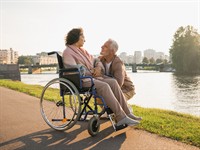
road user — [rəʊd ˈjuːzə(r)] — anyone travelling on a road, including people in vehicles or on motorcycles, bicycles, etc.; jebkurš cilvēks, kurš pārvietojas pa ceļu
Every road user must follow the traffic rules to keep the roads safe for everyone.
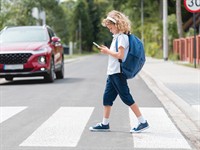
pedestrian — [pəˈdes.tri.ən] — a person walking near or on the road; gājējs
The busy street was full of cars, but the pedestrian waited patiently at the crosswalk, ready to walk safely across when the light turned green.
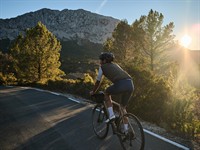
cyclist — [ˈsaɪ.klɪst] — someone who rides a bicycle; riteņbraucējs
The cyclist wore a bright yellow helmet and stayed in the bike lane to stay safe in the busy city traffic.

passenger — [ˈpæs.ən.dʒər] — someone in a vehicle who isn’t driving; pasažieris
All passengers must wear seatbelts.
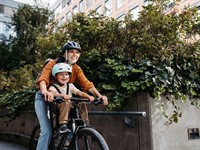
rider — [ˈraɪdə(r)] — a person who travels along on a horse or bicycle; jātnieks, braucējs
The rider signaled before turning left.

driver — [ˈdraɪ.vər] — a person who controls a car or other vehicle; šoferis, vadītājs, braucējs
The driver stopped at the red light.
Part 2: let’s now focus on road safety and learn the words that help us talk about how to protect ourselves and others on the road.
Word bank:
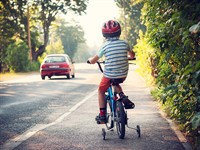
road safety — [ˈrəʊd ˌseɪf.ti] — teaching people how to behave safely when driving or crossing the road; drošība uz ceļa
Learning about road safety helps students understand how to stay safe in traffic.
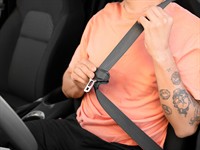
seat belt (also safety belt) — [ˈsiːt belt] — a belt that is attached to the seat in a car or plane and that you fasten around yourself so that you are not thrown out of the seat if there is an accident; drošības josta
You should always use a seat belt when traveling in a car.

car seat — [ˈkɑː ˌsiːt] — a special safety seat for a child that can be fitted into a car; autokrēsls bērniem
Young children must sit in a car seat to travel safely.
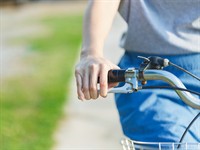
brake — [breɪk] — a device that makes a vehicle go slower or stop, or a pedal, bar, or handle that makes this device work; bremze
He pulled the brake on his bike to slow down at the crossing.
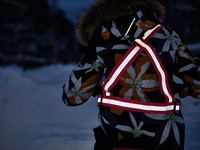
reflector — [rɪˈflek.tər] — a small piece of special glass or plastic that is put on a bicycle, or on clothing, so that it can be seen at night when light shines on it; atstarotājs
The reflector on her jacket made her visible in the dark.
Part 3: let’s now look at road signs — they are the language of the road, helping us understand rules and stay safe.
Word bank:
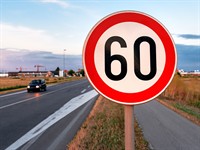
speed limit — [ˈspiːd ˌlɪm.ɪt] — the fastest speed you are allowed to drive; braukšanas ātruma ierobežojums, maksimālais atļautais braukšanas ātrums
The speed limit here is 60 km/h.
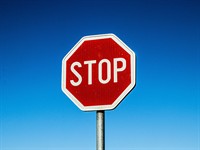
stop sign — [ˈstɒp ˌsaɪn] — a sign that tells drivers to stop completely; ceļa zīme, kas nozīmē, ka transportlīdzeklim ir jāapstājas
You must stop at the stop sign.
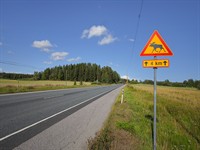
warning sign — [ˈwɔr·nɪŋ ˌsɑɪn] — a sign that shows danger ahead; brīdinājuma zīme
There’s a warning sign for animal crossing.
Part 4: sometimes things don’t go smoothly on the road — problems can appear that cause delays or even danger. Let’s learn the words we need to talk about these situations.
Word bank:
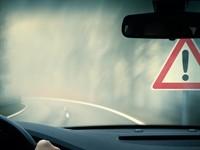
danger — [ˈdeɪn.dʒər] — the possibility of something happening that will injure, harm or kill somebody, or damage or destroy something; briesmas, draudi
Walking on the road without looking can put you in great danger.
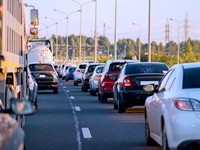
traffic jam — [ˈtræf.ɪk ˌdʒæm] — a situation when there are too many vehicles on the road and they cannot move or can only move very slowly; satiksmes sastrēgums
We were late because there was a traffic jam in the city centre.
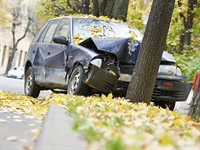
hit — [hɪt] — to touch someone or something with force, often causing damage or injury. On the road, it usually means a vehicle crashes into a person, animal, or object; ietriekties
The car hit a tree during the storm.

fine — [faɪn] — an amount of money that has to be paid as a punishment for not obeying a rule or law; soda nauda
The driver had to pay a fine for parking in the wrong place.
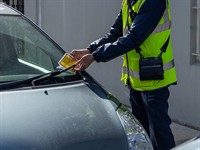
ticket — [ˈtɪk.ɪt] — an official notice that orders you to pay a fine because you have done something illegal while driving or parking your car or other vehicle; soda kvīts
He got a ticket for driving too fast in the city.
Part 5: on the road, some actions keep us safe while others put us in danger — let’s learn how to talk about both.
Word bank:
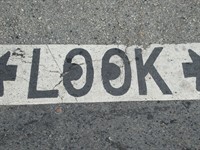
look both ways — look left and right before crossing; skatīties abos virzienos pirms ielas / ceļa šķērsošanas
Always look both ways before crossing the street.
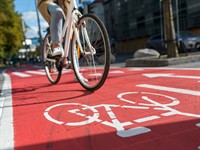
follow the rules — follow road signs and traffic laws; ievērot noteikumus
Cyclists must follow the rules, too.
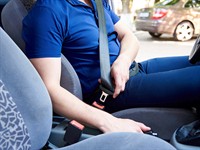
fasten the seat belt — connect and tighten the seat belt in a car, bus, or airplane, so it holds you safely in your seat; piesprādzēt drošības jostu
As soon as Mia got into the car, she reached over to fasten her seatbelt before the engine started.
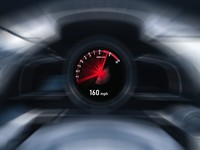
speed — [spiːd] — the rate at which somebody/something moves or travels or to move quickly; braukšanas ātrums (kā lietvārds), ātri braukt (darbības vārds)
The car was going at a very high speed when it passed the school. She always speeds when she's late for work.

wait for the green light — to stay in place and not move (as a driver, cyclist, or pedestrian) until the traffic light turns green, which means it is safe and allowed to go; gaidīt, kad iedegsies zaļā gaisma
Even though there were no cars coming, Jake waited for the green light before crossing the road — safety first!
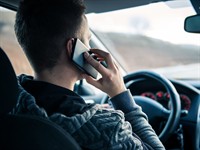
talk on a phone — speak to another person using a telephone or mobile phone; runāt pa telefonu
It is dangerous to talk on the phone while crossing the street.
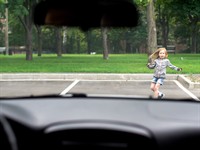
run in front of — to move quickly on foot so that you pass into the space ahead of a person, vehicle, or animal. If you run in front of a moving vehicle, the driver might not have enough time to stop. This can cause an accident; izskriet priekšā (piemēram, automašīnai)
It is very dangerous to run in front of a moving car.
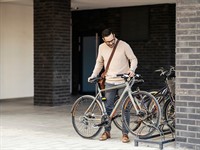
park — [pɑːk] — to put a vehicle in a place where it can stay for a period of time, usually while you leave it; novietot transportlīdzekli tam paredzētajā stāvvietā
Always park your bike in the bicycle stand so it doesn’t block the pavement.
Part 6: to talk about traveling and moving from place to place, we also need some general words that describe where we go and how we get there.
Word bank:
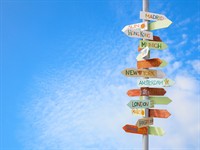
destination — [ˌdes.tɪˈneɪ.ʃən] — the place where someone is going or where something is being sent or taken; galamērķis
After a long journey, we finally reached our destination — a small village by the sea.
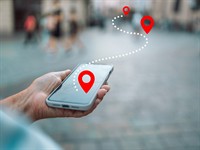
route — [ruːt] — the way you go from one place to another. It can be a road, path, or direction that you follow; maršruts
We took a different route to avoid the traffic jam.
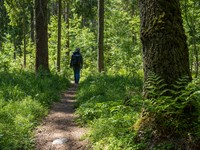
path — [pɑːθ] — a way made for walking, cycling, or sometimes for animals. It is usually smaller than a road and can be in a park, forest, or next to a street. It is often smoother; taka
We walked along the path through the forest.
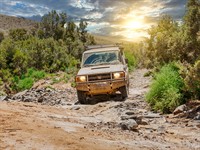
track — [træk] — a path or rough road that is made of soil rather than having a surface covered with stone or other material. It is rougher and less developed; zemes ceļš
The car race was held on a rough track outside the town.
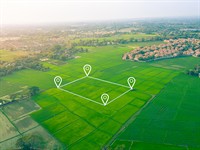
location — [ləʊˈkeɪ.ʃən] — a specific place or position. It tells you where something is; lokācija, atrašanās vieta
The map shows the exact location of the nearest bus stop.